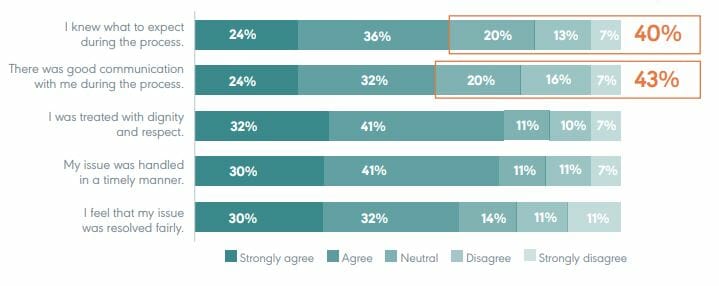In the wake of #MeToo, employees have been emboldened to report inappropriate, illegal and unethical behavior. A survey by my company, HR Acuity, found 56% of employees have experienced or witnessed such behavior in the workplace; 64% have reported it. But our data also shows a troubling trend: 39% of employees aren’t confident their issues will be addressed fairly if they do come forward, and 46% are uncertain and fear retaliation.
Unfortunately, it seems their concerns are well-grounded in experience. Of the 64% of employees who reported inappropriate or unethical behavior, only half saw the issue actually investigated. That’s a troubling reflection on the employers, HR and employee relations teams whose job it is to ensure a fair, equitable and safe environment. It reinforces the belief that reporting issues to HR is pointless because since HR works for the company, they’ll be inclined to protect the employer, leaving the employee hanging out to dry.
When employees don’t feel comfortable coming forward, they’re more likely to quit or worse, air their grievances publicly over social media or through a lawsuit. Both can severely damage a company’s reputation, which hinders recruitment and hiring efforts, as well as overall business performance.
To prevent that downward spiral, HR teams must do everything they can to instill confidence in their employees that any claims of inappropriate or unethical behavior will be 1) handled with discretion and fairness, 2) investigated fully, and 3) resolved with zero tolerance for retaliation.
Here are three tips that can help HR to build (or rebuild) trust and instill (or restore) employees’ confidence in the reporting process:
1. Establish clear expectations
When something goes wrong, employees need to know what they can expect from the company, and what’s expected of them. However, in our survey 27% of those who reported an issue said they didn’t know if it was ever investigated — they were left completely in the dark, which certainly didn’t instill confidence.
Instead, establish and communicate clear protocols for how the process works step-by-step. Outline expectations and clarity around confidentiality, a rough estimate on how long the process might take, who will be involved and how often an employee will hear from HR with an update. As a rule of thumb, check in with the involved employees regularly, even if you don’t need any new information or have anything new to report. Just touching base occasionally lets them know you care, and that the issue hasn’t been forgotten or swept under the rug. When it comes to communication, more is more.
2. Be transparent about the process and outcomes
It’s OK if you don’t know all the answers right now. Being upfront throughout the process at least lets employees know you’re working on a resolution.
And, be clear about the resolution, too. In some organizations, the claimant is not informed about sanctions against the offender, even if claims are validated, under the guise of employee confidentiality. The claimant knows the accused violated policy, but were there any repercussions? Blanket statements like “We’ve taken action to make sure it doesn’t happen again,” do NOT instill confidence. Be clear about disciplinary actions taken, so that employees know something will be done and there are consequences for bad behavior.
It’s also wise to ask for the same transparency in return from employees who report issues. Ask for their feedback, through a survey or thorough conversation. Ask how the process went for them, whether the issue was handled in a timely fashion, if they were treated with dignity and respect throughout the process and whether they’d recommend HR to a co-worker. This reinforces that you care about them and their work environment, that you take your responsibility to them seriously and that you’re willing to hold your organization accountable. And if the feedback isn’t good, leadership needs to dive in and figure out why the process is broken.
3. Use technology to report and track
Establishing, tracking and reporting on issues, investigations and processes is extremely difficult and time-consuming with manual tools like spreadsheets or paper forms. They take too long to complete and waste resources. They’re hard to keep up to date, which makes it difficult to keep the parties updated on progress, and they’re ineffective for tracking metrics. As for identifying insight, forget about it.
Implementing an employee relations management platform provides the consistent process, transparency and data tracking that instills confidence among employees. Not only can an ER platform provide automated workflows that keep reporting and investigations consistent and on-track, but it also helps the organization examine its own performance in handling, resolving and ultimately preventing claims. For example, if multiple people complain about the same person from different perspectives, the software can surface this red flag for deeper investigation. And, it can help spot trends in worsening or improving behavior that can signal a cultural shift.
Transparency is best
As many of the big Silicon Valley tech firms began coming forward in the wake of #MeToo with information about claims filed by their employees, many business leaders cringed. Why would a company air their dirty laundry out in the open?
The truth is that, while some may think reported claims of inappropriate behavior are a big risk to the organization, it’s actually those that go unreported and uninvestigated that pose a much bigger threat. Allowing these situations to fester beneath the surface creates a toxic environment that will eventually boil over into scandal or sharp performance decline.
Being transparent, taking action and demonstrating your commitment to improving workplace culture has a tremendous positive impact on both HR’s and the company’s reputation. In fact, our research shows that employees who experience issues that are investigated and resolved are just as likely to recommend the company as a place to work as those who never experience an issue at all.
While you may not be able to prevent all bad behavior, having consistent, fair and transparent processes for handling it when it does occur is a huge strategic advantage for any organization. Step on the side of trust, communication and transparency. Your employees expect it. Let’s not let them down.
